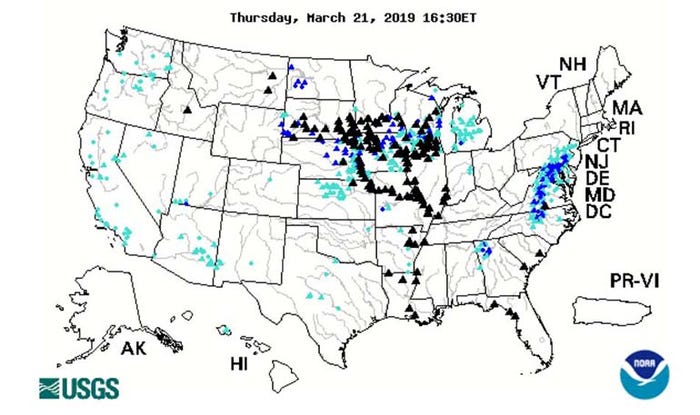
The latest bout of flooding across large portions of the Midwest and Plains have already cost life, livestock and infrastructure damage. Now, experts are worried about another victim – stored grain in the affected areas.
In one county alone – Freemont County in southwestern Iowa – damage estimates included 1.34 million bushels of corn and another 390,000 bushels of soybeans. After a quick look at the latest USGS/NOAA flood map, it’s easy to anticipate tens of millions of bushels could be at risk.

“We couldn’t unload [our grain] fast enough,” said Iowa farmer and U.S. Grains Council Director Duane Aistrope, although they were able to move about 42,000 bushels of stored grain to a nearby farm ahead of the flooding.
Some farmers weren’t even able to move equipment before floodwaters encroached on their operations, added Iowa farmer Julius Schaaf.
“Nobody has ever seen something like this before – it just caught everybody off guard,” he said. “There’s thousands of those stories up and down the river, on the Nebraska side and the Iowa side. This is unbelievably cruel.”
Once the waters recede, farmers will have to deal with any stored grain that was affected. Unfortunately, their options are somewhat limited, writes Charles Hurburgh, agricultural and biosystems engineering professor with Iowa State University.
“The good grain should be removed immediately, again not down through the soaked grain,” he said. “No flooded grain can be sold to any market without approval of FDA, to document its exposure only to uncontaminated water, with subsequent reconditioning for an intended use. The flooded grain in 2019 is primarily from river water, which is considered contaminated.”
Hurburgh also recommends a seven-point action checklist, outlined here.
The grain bins themselves can also incur damage, so Hurburgh recommends farmers closely inspect those structures as soon as they are able.
“Grains swell when wet so bin damage is likely; more so with soybeans,” he said. “Bolts can shear or holes can elongate. Look for signs such as stretched caulking seals, doors misaligned or similar structural problems. Farm bins typically have lighter-grade steel and fasteners than commercial bins. Stay aware for signs of failure when working around bins containing wetted grain. Check bins with stirring devices carefully. The bin must be perfectly round for them to work correctly.”
Farmers will also want to get on the phone with their crop insurance provider sooner rather than later, according to Mike Scherer, president of Ag Risk Solutions.
“Most hail insurance policies have at least some stored grain coverage in them,” he noted. “The details vary greatly between companies, but you need to check into it.”
Governmental assistance may also be available, as U.S. Secretary of Agriculture Sonny Perdue recently directed USDA to “aid people in their recovery efforts.”
“I encourage area farmers and ranchers to contact their local USDA Service Center so we can work with them to identify the resources and tools needed to reestablish their operations,” he said. “While farmers and ranchers in the area are resilient, the pain is real. We will do everything in our power at USDA to be as helpful as we possibly can.”
If you live in Nebraska, the Nebraska Farm Bureau has also established a disaster relief fund to provide additional emergency. 100% of donations will be distributed to Nebraska farmers, ranchers and rural communities. Click here to learn how to donate or apply for aid.
About the Author(s)
You May Also Like






